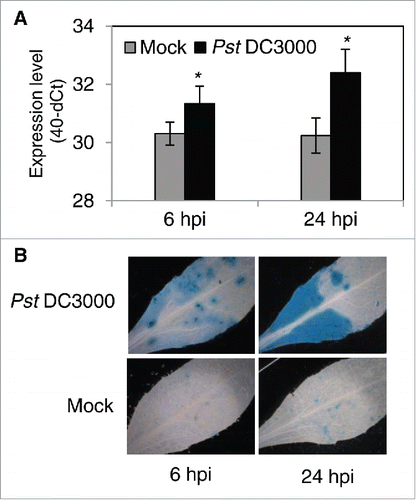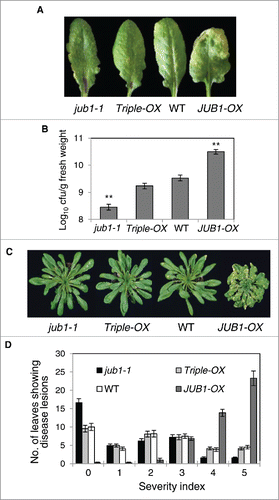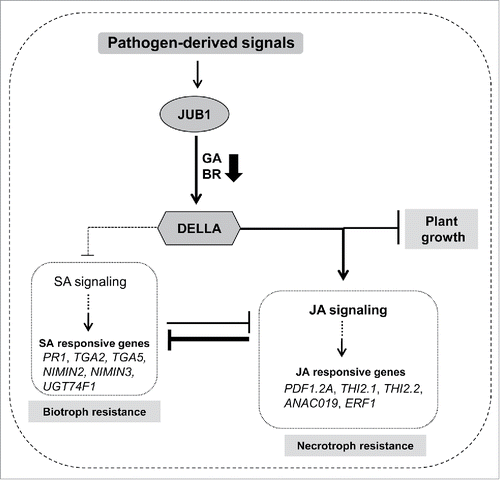Figures & data
Figure 1. Induction of JUB1 upon infection with Pst DC3000. (A) Expression level of JUB1 measured by qRT-PCR in 5-week-old WT plants sprayed with Pst DC3000 compared to mock (10 mM MgCl2) treated plants, 6 and 24 hpi. Means ± SD (n = 3). Asterisks indicate a significant difference from Mock (*p < 0.05; Student´s t-test). (B) Histochemical analysis of GUS expression in rosette leaves of 5-week-old ProJUB1:GUS plants, 6 and 24 h after pressure infiltration with Pst DC3000 or MgCl2 (mock).

Figure 2. Defense responses observed in JUB1-OX are fully restored in Triple-OX plants. (A) Rosette leaves of 5-week-old plants pressure infiltrated with Pst DC3000 at 2 dpi. The experiments were repeated 3 times and similar results were obtained. (B) In planta growth of Pst DC3000 bacteria in JUB1 transgenics and WT, assayed 3 dpi. Data are from 2 experiments with at least 8 plants per genotype in each. Mean growth ± SD. Asterisks indicate a significant difference from WT (**p < 0.01; Student´s t-test). (C) Defense response of plants sprayed with Pst DC3000 at 5 dpi. The experiment was repeated 4 times with similar results. (D) Disease severity index (according to lesion diameters; 0, small chlorotic lesions; 5, large lesions) assessed in plants shown in (C). Data are from 3 experiments with at least 8 plants per genotype in each. Means are shown ± SD.

Figure 3. SA- and JA-responsive defense genes differentially expressed in JUB1 transgenic plants compared to WT. Gene expression was quantified by qRT-PCR in rosettes of 5-week-old JUB1 transgenics compared to WT, 6 h after spraying with Pst DC3000. FCh, fold change. Means ± SD (n = 3). Asterisks indicate a significant difference from WT (*p < 0.05; Student´s t-test).

Figure 4. Model showing the function of JUB1 during pathogen attack. A working model showing the JUB1-mediated defense response mechanism; JUB1 expression is induced by various pathogen-derived signals, and it mediates the plant's response to pathogen attack through accumulation of DELLA proteins resulting in activated JA defense signaling, but an attenuated SA defense response leading to enhanced susceptibility to Pst DC3000. This study also emphasizes the role of JUB1 for the regulation of plant growth and defense crosstalk.

